背景
公司产品微服务架构下有十几个模块,几乎大部分模块都要连接redis。每次在客户那里部署应用,都要改十几遍配置,太痛苦了。当然可以用nacos配置中心的功能,配置公共参数。不过我是喜欢在应用级别上解决问题,因为并不是每个项目都会使用nacos,做个知识储备还是不错的。
公共配置文件位置
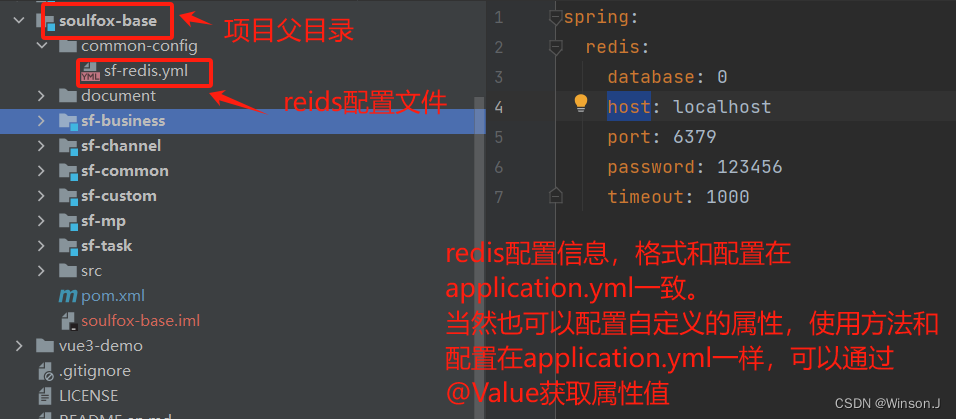
启动本地redis(windows版)
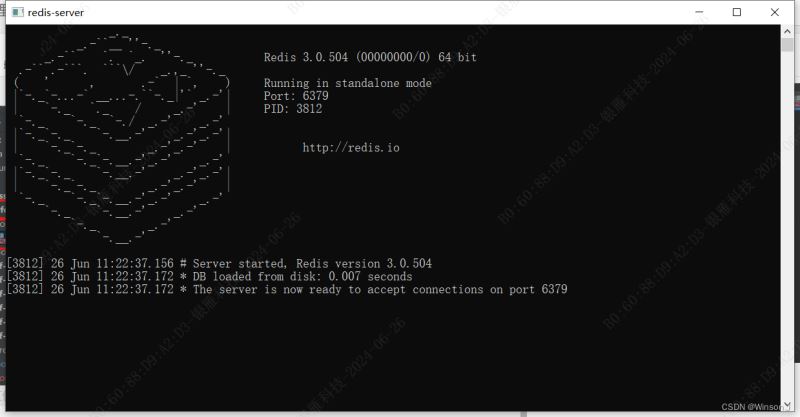
当前redis 没有数据
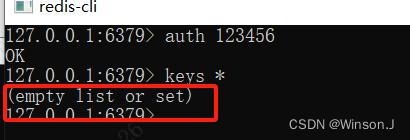
初始化redis
这里的初始化和正常把redis配置信息放到application.yml里的初始化是一样的。
1 2 3 4 5 6 7 8 9 10 11 12 13 14 15 16 17 18 19 20 21 22 23 24 25 26 27 28 29 30 31 32 33 34 35 36 37 38 39 40 | package cn.com.soulfox.common.config;import lombok.extern.slf4j.Slf4j;import org.springframework.boot.autoconfigure.condition.ConditionalOnClass;import org.springframework.boot.autoconfigure.condition.ConditionalOnMissingBean;import org.springframework.boot.autoconfigure.data.redis.RedisProperties;import org.springframework.boot.context.properties.EnableConfigurationProperties;import org.springframework.context.annotation.Bean;import org.springframework.context.annotation.Configuration;import org.springframework.data.redis.connection.RedisConnectionFactory;import org.springframework.data.redis.core.RedisOperations;import org.springframework.data.redis.core.RedisTemplate;import org.springframework.data.redis.serializer.JdkSerializationRedisSerializer;import org.springframework.data.redis.serializer.StringRedisSerializer;/** * * @create 2024/4/11 10:48 */@Configuration@ConditionalOnClass(RedisOperations.class)@EnableConfigurationProperties(RedisProperties.class)@Slf4jpublic class RedisTemplateConfig { @Bean @ConditionalOnMissingBean(name = "redisTemplate") public RedisTemplate getRedisTemplate(RedisConnectionFactory factory){ log.info("开始初始化 RedisTemplate ------------------"); RedisTemplate redisTemplate = new RedisTemplate(); // key的序列化类型 redisTemplate.setKeySerializer(new StringRedisSerializer()); redisTemplate.setHashKeySerializer(new StringRedisSerializer()); redisTemplate.setHashValueSerializer(new JdkSerializationRedisSerializer()); redisTemplate.setValueSerializer(new JdkSerializationRedisSerializer()); redisTemplate.setConnectionFactory(factory); log.info("初始化 RedisTemplate 结束------------------"); return redisTemplate; }} |
解析自定义sf-redis.yml
1 2 3 4 5 6 7 8 9 10 11 12 13 14 15 16 17 18 19 20 21 22 23 24 25 26 27 28 29 30 31 32 33 34 35 36 37 | package cn.com.soulfox.business.config;import org.springframework.beans.factory.config.YamlPropertiesFactoryBean;import org.springframework.context.annotation.Bean;import org.springframework.context.annotation.Configuration;import org.springframework.context.support.PropertySourcesPlaceholderConfigurer;import org.springframework.core.io.FileSystemResource;import org.springframework.stereotype.Component;/** * * @create 2024/6/26 16:41 */@Configurationpublic class CommonConfig { @Bean("common-config") public static PropertySourcesPlaceholderConfigurer properties() { PropertySourcesPlaceholderConfigurer configurer = new PropertySourcesPlaceholderConfigurer(); YamlPropertiesFactoryBean redis = new YamlPropertiesFactoryBean(); //文件路径写死的,真正做项目时,文件路径可以配置到application.yml文件 FileSystemResource redisResource = new FileSystemResource("../common-config/sf-redis.yml"); redis.setResources(redisResource); configurer.setPropertiesArray(redis.getObject()); //如果有多个配置文件,也是可以处理的。setPropertiesArray(Properties... propertiesArray)方法的参数是个数组, //如下还可以同时处理文件sf-ports.yml,此时configurer.setPropertiesArray(redis.getObject());代码要注释掉 //YamlPropertiesFactoryBean ports = new YamlPropertiesFactoryBean();// FileSystemResource portsResource = new FileSystemResource("../common-config/sf-ports.yml");// ports.setResources(portsResource); //同时添加sf-redis.yml和sf-ports.yml的配置信息// configurer.setPropertiesArray(redis.getObject(), ports.getObject()); return configurer; }} |
应用启动类
注意一下,因为我已经搭建了完整的微服务,包括nacos,mybatis,feign等,所有启动类上注解比较多。如果只是单纯测试一下,引入springboot基础框架和redis依赖,写一个基础启动类就可以了。
1 2 3 4 5 6 7 8 9 10 11 12 13 14 15 16 17 18 19 20 21 22 23 24 25 26 27 28 29 30 31 | package cn.com.soulfox.business;import org.springframework.beans.factory.config.YamlPropertiesFactoryBean;import org.springframework.boot.SpringApplication;import org.springframework.boot.autoconfigure.SpringBootApplication;import org.springframework.cloud.client.discovery.EnableDiscoveryClient;import org.springframework.cloud.openfeign.EnableFeignClients;import org.springframework.context.annotation.Bean;import org.springframework.context.annotation.ComponentScan;import org.springframework.context.support.PropertySourcesPlaceholderConfigurer;import org.springframework.core.io.FileSystemResource;import org.springframework.core.io.PathResource;import org.springframework.core.io.Resource;import org.springframework.transaction.annotation.EnableTransactionManagement;import tk.mybatis.spring.annotation.MapperScan;import java.io.File;@SpringBootApplication@EnableDiscoveryClient//nacos注册中心@EnableFeignClients(basePackages = {"cn.com.soulfox.common.feign.client"})//feign扫描@MapperScan(basePackages={"cn.com.soulfox.*.mvc.mapper"})//mybatis mapper扫描@EnableTransactionManagement//开启数据库事务@ComponentScan("cn.com.soulfox")public class BusinessApplicationRun { public static void main(String[] args) { SpringApplication.run(BusinessApplicationRun.class, args); }} |
启动一下应用看看redis是否初始化成功

测试一下是否可以正常使用
单元测试类
1 2 3 4 5 6 7 8 9 10 11 12 13 14 15 16 17 18 19 20 21 22 23 24 25 26 27 28 29 30 31 32 33 | package cn.com.soulfox.common.config;import cn.com.soulfox.business.BusinessApplicationRun;import org.junit.Test;import org.junit.runner.RunWith;import org.springframework.beans.factory.annotation.Autowired;import org.springframework.beans.factory.annotation.Value;import org.springframework.boot.test.context.SpringBootTest;import org.springframework.data.redis.core.RedisTemplate;import org.springframework.test.context.junit4.SpringRunner;/** * * @create 2024/6/26 16:52 */@RunWith(SpringRunner.class)@SpringBootTest(classes = BusinessApplicationRun.class, webEnvironment = SpringBootTest.WebEnvironment.RANDOM_PORT)public class CommonConfigTest { @Autowired private RedisTemplate redisTemplate; //文件sf-redis.yml里属性的使用和applications.yml一样 @Value("${spring.redis.host}") private String redisHost; @Test public void test(){ System.out.println("从文件取参数测试+++++++++++"); System.out.println("redisHost: " + redisHost); }} |
测试sf-redis.yml属性使用
使用方法和配置在application.yml文件是一样,都是通过@Value注解获取
测试结果
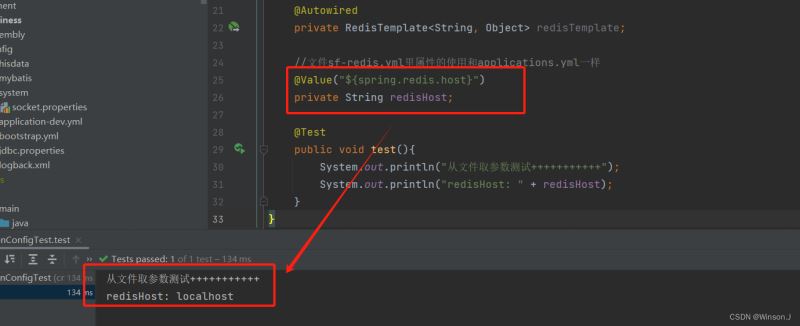
测试redis是否可以正常使用
测试写入数据,增加以下测试方法
1 2 3 4 | @Testpublic void testRedisSetValue(){ this.redisTemplate.opsForValue().set("test", "test123");} |
测试结果
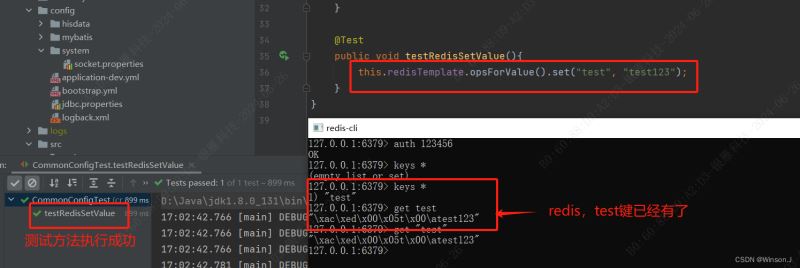
测试读取数据,增加以下测试方法
1 2 3 4 5 | @Testpublic void testRedisGetValue(){ Object testValue = this.redisTemplate.opsForValue().get("test"); System.out.println(testValue);} |
测试结果

总结一下
现在的微服务,大多使用nacos作为注册中心,同事nacos也能作为配置中心使用。公共配置一般放在nacos中,以上方法没有什么用处。但总有项目可能不会使用nacos,比如使用eureka,这时候以上方法就有用武之地。这个方法可以作为知识储备,了解一下总是有好处的 :–)
还有一点需要注意的,就是yml文件是在程序启动后解析的,所以文件里的配置信息,在application.yml里是不能通过${xxx.xxx}使用的。
以上就是SpringBoot解析自定义yml文件的流程步骤的详细内容,更多关于SpringBoot解析yml文件的资料请关注IT俱乐部其它相关文章!

